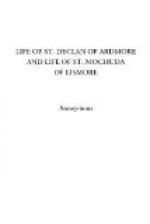(II.) Absence of Declan’s name from the Acts of Patrick is a negative argument. It is explicable perhaps by the supposed irregularity of Declan’s preaching. Declan was certainly earlier than Mochuda and yet there is no reference to him in the Life of the latter saint. Ailbhe however is referred to in the Tripartite Life of Patrick and the cases of Ailbhe and Declan are “a pari”; the two saints stand or fall together.
(IV.) Motives for invention of the pre-Patrician myth are alleged, scil.:—to rebut certain claims to jurisdiction, tribute or visitation advanced by Armagh in after ages. It is hard to see however how resistance to the claims in question could be better justified on the theory of a pre-Patrician Declan, who admittedly acknowledged Patrick’s supremacy, than on the admission of a post-Patrician mission.
That in Declan we have to deal with a very early Christian teacher of the Decies there can be no doubt. If not anterior to Patrick he must have been the latter’s cotemporary. Declan however had failed to convert the chieftain of his race and for this—reading between the lines of the “Life”—we seem to hear Patrick blaming him.
The monuments proper of Declan remaining at Ardmore are (a) his oratory near the Cathedral and Round Tower in the graveyard, (b) his stone on the beach, (c) his well on the cliff, and (d) another stone said to have been found in his tomb and preserved at Ardmore for long ages with great reveration. The “Life” refers moreover to the saint’s pastoral staff and his bell but these have disappeared for centuries.
The “Oratory” is simply a primitive church of the usual sixth century type: it stands 13’ 4” x 8’ 9” in the clear, and has, or had, the usual high-pitched gables and square-headed west doorway with inclining jambs. Another characteristic feature of the early oratory is seen in the curious antae or prolongation of the side walls. Locally the little building is known as the “beannacan,” in allusion, most likely, to its high gables or the finials which once, no doubt, in Irish fashion, adorned its roof. Though somewhat later than Declan’s time this primitive building is very intimately connected with the Saint. Popularly it is supposed to be his grave and within it is a hollow space scooped out, wherein it is said his ashes once reposed. It is highly probable that tradition is quite correct as to the saint’s grave, over which the little church was erected in the century following Declan’s death. The oratory was furnished with a roof of slate by Bishop Mills in 1716.
“St. Declan’s Stone” is a glacial boulder of very hard conglomerate which lies on a rocky ledge of beach beneath the village of Ardmore. It measures some 8’ 6” x 4’ 6” x 4’ 0” and reposes upon two slightly jutting points of the underlying metamorphic rock. Wonderful virtues are attributed to St. Declan’s Stone, which, on the occasion of the patronal feast, is visited




